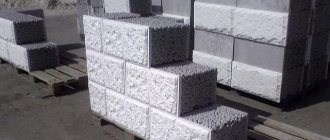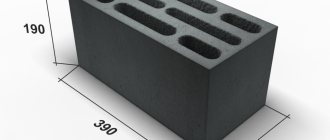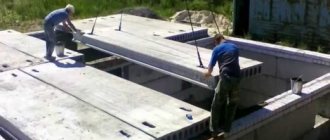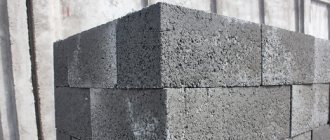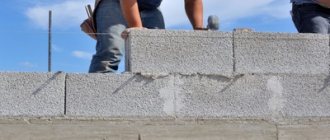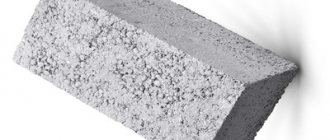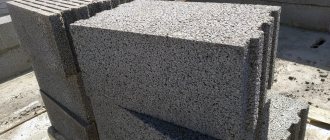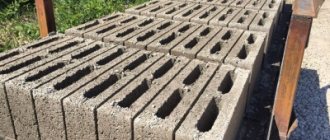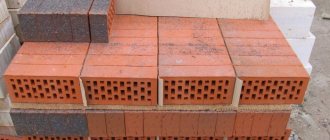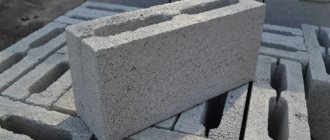Various materials are used for construction, traditional brick and concrete are often used. But what exactly is better, how good are modern expanded clay concrete blocks, which are offered not only for the construction of walls, but also for their insulation? Isn’t it easier to use a relatively cheap foam block, which is easy to process, or aerated concrete, which has recently become quite common? It is necessary to pay attention to the characteristics of brick and expanded clay concrete, find out the pros and cons, and compare them with other building materials offered on the market. Attention can be paid to the foam block. Today, several varieties of brick and expanded clay concrete are offered, so you need to choose carefully.
Expanded clay block
Wall (structural) material is used for the construction of load-bearing walls . This type of expanded clay block is the most durable and can withstand pressure up to 5 MPa . Load-bearing structures in two- and three-story buildings are erected from a solid block. Hollow models are only suitable for one-story houses in order to retain the maximum amount of heat.
Wall
The partition (wall) expanded clay block has smaller dimensions than the wall one. The height is greater than the width, since the material will not be subject to large loads, temperature changes are insignificant. Hollow partition blocks are installed as a heat-insulating material, while solid ones are used for strong internal walls and small extensions outside.
Septal
Cladding expanded clay block is used for finishing the outside of walls. Elements may have a painted layer or a decorative coating. For this, natural colored clay or chemical pigments are used. Industrial raw materials are characterized by better resistance to external influences.
Facing
Decorative finishing can be made to look like stone, plaster or lining. Such models are large in size and replace 4-5 standard blocks.
Decorative finishing
The optimal size of a ceramic block is 190*390*90 mm . The material is laid in 1 layer. The masonry can be used as a base. It has frost-resistant and heat-insulating properties and is easy to process.
Specifications:
- Low water permeability (with low expanded clay content.
- Environmentally friendly (no toxic emissions.
- Average compressive strength.
- High frost resistance.
- Minimal shrinkage and destruction of the structure.
Aerated concrete and cinder block
Cinder block is another option for reducing the cost and lightening of concrete by introducing filler - slag. The cost of the material is very affordable.
- Cinder blocks are higher in strength, as is expanded clay concrete. The building can be built without armored belts and reinforced lintels.
- The thermal conductivity is much lower. In addition, the material does not accumulate heat: a house made of slag concrete heats up quickly and cools just as quickly. There is no point in using it as insulation.
- The most common laying of cinder blocks is on mortar, that is, it involves the formation of “cold bridges”.
Now let's find out which is better: polystyrene concrete or aerated concrete.
Brick
Classic ceramic red brick is produced by firing clay and its impurities. Another type is silicate , obtained from solidified limestone solution in an autoclave.
The standard material size is 250x120x65 mm . This brick is called single. Its main advantage is the multiple of 1 meter, which is convenient when calculating material consumption. Also, there are one-and-a-half models (height 88 mm ), double ones and with many times increased dimensions.
The original color is obtained after firing the raw material. Adding natural colored clay or chemical elements allows you to get a variety of shades. Standard silicate material is white. By adding pigments you can give a different shade.
Ceramic brick production methods:
- Plastic . Clay (water content 17-30%) is formed into blocks under a belt press. Bricks are dried in a special chamber or under a canopy. The last stage is firing in a kiln and sending it to the warehouse.
- Semi-dry pressing . Raw materials with a water content of 8-10% are used. The blocks are formed under a pressure of 15 MPa. Drying takes place in a chamber or tunnel method.
General technical specifications
Expanded clay bricks and bricks can be used for various construction works:
- Construction of load-bearing, interior and partition structures.
- Installation of the base for further finishing.
- External cladding of the facade.
The strength of the materials is the same . The erected structure is not subject to shrinkage even after a long period of use. Expanded clay block and brick are the most durable building products. The structure has been preserved for years.
The materials are resistant to sudden temperature changes and severe frosts. Expanded clay block and brick can withstand 50 cycles of freezing and thawing . This is the most optimal indicator for a building material.
In the production of expanded clay blocks and bricks, safe and environmentally friendly raw materials . The product does not emit toxic substances even after long service.
The materials are suitable for the construction of residential and industrial buildings. The products are popular for the construction of private houses due to their technical characteristics. To diversify the color palette, tint grades of clay or chemical pigments are added to the composition.
Working with facing bricks
This brick is superior to ordinary clay brick in its performance. The development is as follows. Limestone is mixed with cement and water; if you need to change the color, a dye is used. And under the highest pressure of 300 tons, the pressing process takes place. Thanks to our own production technology, hyperpressed brick has improved qualities:
Brick wall cladding
- highest strength;
- good frost resistance;
- weak water absorption, lower than that of clay bricks;
- correct geometric shape, facilitating the work of the stacker;
- hyperpressed brick is an environmentally friendly material, only limestone and cement are used in production;
- due to excellent interaction with matter, the finished system is similar to a monolith;
- Application in systems with weight restrictions is unrealistic, because it is quite heavy.
- This brick has the highest thermal conductivity, so additional insulation will be useful before cladding.
- Working with this material requires special care; due to adhesion, it will be virtually impossible to remove excess solution from the surface.
Facing it with such bricks allows you to make various decorated elements. There are a huge number of colors and shapes of the hyper-pressed block, which will allow you to decorate the facade of the house in an original way.
Expanded clay
This facing brick entered into facing work relatively recently. The production development is similar to expanded clay concrete, only expanded clay in granules is used as a filler. It competes at the proper level with other facing materials in terms of the following capabilities:
Expanded clay brick photo
- strength, it resists external and mechanical actions and its own weight;
- frost resistance, withstands extreme frosts;
- service life is at least 15 years;
- it is characterized by good thermal insulation;
- sound absorption is at the proper level;
- resistance to various fungi and mold.
This material also has its own personality:
- The weight is very small with the product dimensions 60x30x40cm;
- The surface of expanded clay brick is embossed, not counting the back sides, which ensure even laying;
- When laying, this product requires an air cushion between the wall of the house and the facing layer, the absence of which will lead to the accumulation of water;
Let's look at the process of laying with one of the materials listed above - facing bricks.
Cladding of expanded clay concrete
The main task of facing work is decoration and protection from precipitation, closing open pores on the surface of the blocks. There is no special instruction for facing expanded clay concrete; you just need to take certain tips into account. The main wall must have a connection with the facing layer. The presence of a foundation for this layer is essential; a common base with a load-bearing wall can be used. Before carrying out such work, it is necessary to ensure that the erected wall structures have achieved the required strength. For this process, you will need the same tools and mortar as for laying expanded clay concrete blocks.
Fundamental point! A coating made of such bricks will be “cool”, therefore, before starting the cladding process, expanded clay concrete must be insulated in advance.
The following can be used as insulation:
- mineral wool;
- Styrofoam;
- fiberglass boards;
Distinctive features
- Dimensions . According to standard dimensions, expanded clay block is larger than red brick. 1 block can replace brickwork of 3-7 elements. This allows the construction of the structure to be carried out faster and easier. Due to the large size, it is more difficult to regulate the evenness of the installation.
- Appearance . Classic ceramic brick is made in red shades. The material most often has warm colors. The standard expanded clay block is gray in color. Some models are decoratively processed to imitate other materials.
- Volume weight . The characteristics of expanded clay blocks vary from 700 to 1500 kg/m³. Brick has a higher rate - from 1000 to 2000 kg/m³.
- Water absorption . This parameter shows how much moisture the structure will absorb from the environment. Water absorption of expanded clay block is 50%, brick - 40%. The second option is more resistant to a humid environment and better retains its structure even with regular heavy rainfall and during the period of snow melting.
- Thermal conductivity . The blocks retain heat in the house better, their indicator is 0.15-0.45 W/m3. For red brick, this parameter is higher (0.3-0.8 W/m3), which is why the temperature transfer to the environment is greater.
- Price . With the same technical characteristics, the price of 1 m3 of expanded clay block starts from 2555 rubles. The same volume of brickwork will cost 6,200 rubles.
What is better: expanded clay concrete blocks or aerated concrete blocks?
There is an opinion that expanded clay concrete is almost a garage-made material. This is outdated information. Today there are serious companies on the market that produce high-quality expanded clay concrete blocks that are free from the shortcomings that are often mentioned on the Internet. Both the geometry and heat-shielding properties of these blocks are much better than those of their predecessors.
Nevertheless, aerated concrete blocks have a number of advantages over expanded clay concrete blocks:
- Low price. If you want to buy high-quality wall blocks, then m 3 of aerated concrete will cost 20-30% less than m 3 of expanded clay concrete.
- Better heat-shielding properties. Any of these materials makes it possible to build single-layer (not insulated) external walls that will meet the requirements of building codes for the European part of Russia. However, depending on the material, the thickness of the walls will vary.
Walls made of YTONG aerated concrete blocks (Xella Russia), popular on our market, with a density grade of D400 and a thickness of 375 mm provide heat transfer resistance R = 3.45 W/(m 2 °C). Regulatory requirements for central Russia are 3.15 W/(m 2 °C), so the performance of aerated concrete even exceeds them. While walls made of expanded clay concrete “fit” into the requirements only with a thickness of 400 mm. In other words, walls made of aerated concrete can be made thinner and at the same time they will be “warmer”.
- Higher frost resistance. The amount of frost resistance directly indicates the service life of the stone wall material. The higher it is, the more durable the material. The frost resistance grade of aerated concrete blocks is F100, while the best examples of expanded clay concrete are F50, and more often it is even lower - F25-F35. In principle, even F35 is a good indicator for wall material. But in any case, aerated concrete blocks are more durable than even the highest quality expanded clay concrete blocks.
- Higher fire resistance. According to tests, a structure made of YTONG aerated concrete will retain its load-bearing capacity for 360 minutes, and expanded clay concrete structures - a maximum of 180 minutes.
- Convenient and quick installation. Compared to aerated concrete, expanded clay concrete has a higher density (D800-D1200), and therefore products made from it are very heavy. To make expanded clay concrete blocks easier to lay, their dimensions are made smaller. But because of this, firstly, the laying speed decreases (you have to bring the blocks more often). Secondly, there are more seams between the blocks, and, as you know, seams are cold bridges through which precious heat escapes from the house. Thirdly, such dense blocks are difficult to cut or groove; for this you need, for example, a grinder with an expensive diamond disc for concrete.
Aerated concrete is free from these disadvantages. The blocks are noticeably larger and at the same time slightly heavier (about 5 kg). The laying speed is higher. There are fewer seams, which means there are fewer cold bridges. You can even cut and groove aerated concrete with a hand-held, non-motorized tool, and this can be done very quickly.
- There are additional elements that manufacturers of expanded clay concrete do not have. The YTONG line contains elements for reliable and quick installation of standard complex building components. For example, there are U-blocks, arc-shaped blocks, O-blocks for chimneys and ventilation ducts, ready-made lintels for window and door openings, components for the installation of prefabricated monolithic floors, which are on sale from our partners. All of them significantly simplify and speed up installation, and also make the structure of the house more durable.
